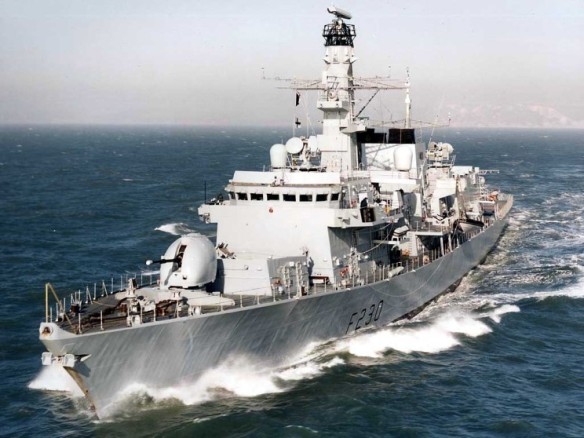HMS Norfolk, the lead ship of the class, was launched in 1987 and commissioned in 1990. It was followed by a further 15 ships of which the last, HMS St Albans, will be completed in mid-2002. At one time it was hoped that more would be ordered, but even a total of 16 makes it the largest class of British post-war frigates apart from the Leander class (26 ships).
Originally intended as a cheap replacement for the large and complex Type 22 frigates, the Duke class eventually matured into a sophisticated general-purpose frigate with substantial anti-surface ship and anti-submarine capabilities The hangar and flight deck were designed to accommodate the Merlin HM. 1 helicopter which entered service from late 1999 onwards, although a Lynx HMA. 3/8 is normally embarked pending the availability of the larger machine. Virtually all the armament is concentrated on the foredeck, making these ships vulnerable to being disabled by a single hit. The main exception is the internal magazine torpedo launch system (MTLS) which is located in the forward section of the hangar superstructure. This enables the twin torpedo tubes to be reloaded with Stingray ASW torpedoes in less than 10 minutes. The design incorporates some stealth technology intended to reduce the ships’ IR and acoustic signatures, while the shape of the hull and superstructure reduces radar echoes.
The complexity of modern weapon systems demands a sophisticated computerised combat data and command system. The original CACS-4 system specified for the Type 23 proved to be unsuitable for the task and was cancelled in 1987 in favour of the SSCS (surface ship command system). However, this took some time to develop and consequently it was not available for installation until the eighth ship, HMS Westminster, which commissioned in 1994. In the meantime the earlier ships had to do without an integrated system and consequently were not available for deployment in the 1991 Gulf War. SSCS is now being retrofitted to all these ships while subsequent Type 23s have the upgraded Phase III, IV or V SSCS.
SPECIFICATION
Type: FG Class: Duke (Type 23)
Displacement: 3,500 tons standard, 4,200 tons full load Length: 436.2ft (133m)
Beam: 528ft (16.1 m)
Draught: 18ft (7.3m)
Machinery: CODLAG; 2 Rolls-Royce Spey SMl A gas turbines, 31 ,000hp; 4 Paxman 12CM diesels, 8,1 OOhp; 2 GEC motors; 2 shafts
Speed & Range: 28kt; 8,980 miles (14,450km) at 15kt
Complement: 181 Missiles: 2 quadruple launchers, Boeing Harpoon long-range SSM; 32-canister VLS silo, GWS 26 Seawolf short-range SAM Guns: 1 Vickers 45in (115mm)/55 Mk. 8 automatic gun; 2 DS30B single 30mm guns ASW & USW: 2 fixed twin 324mm (1275in) torpedo tubes with automatic reload, Stingray A/S torpedoes Sensors: radar: Type 996 3D air and surface search; Type 1007 navigation; Type 911 fire control; sonar: Type 2050 bow-mounted active search and attack; Type 2031 Z passive towed array or Type 2087 towed active and passive array
Aircraft: 1 helicopter
LINK
